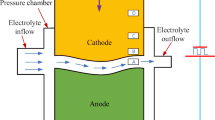Abstract
For the time scale of the applied pulses is orders of magnitude smaller than the time scale on which the workpiece is machined, simulation of the temperature evolution and the changes of the workpiece shape in pulse electrochemical machining (PECM) process would be a computationally very expensive procedure. A multi-physics model and the quasi steady state shortcut (QSSSC) approach are presented for modeling the temperature evolution in PECM process. By defining a critical upper limit, a simplified algorithm is introduced to simulate the changes of workpiece shape in PECM process. The assumption is made that geometry structure is fixed before the system reaches the quasi steady state (QSS) and the material removal is calculated by current density when the QSS is reached. Simulation results indicate that the simplified algorithm is convenient for the calculation of the shape change of the electrodes. The validity of the simplified algorithm is verified by the comparison of workpiece profiles obtained by simulation prediction and experiments.
Similar content being viewed by others
References
Rajurkara KP, Sundaram MM, Malshe AP (2013) Review of electrochemical and electrodischarge machining. Procedia CIRP 6:13–26
Alexandre S, Atanas I (2013) Recent developments and research challenges in electrochemical micromachining (μECM). Int J Adv Manuf Technol 69(563–581):3
Mithu MAH, Fantoni G, Ciampi J (2011) A step towards the in process monitoring for electrochemical microdrilling. Int J Adv Manuf Technol 57:969–982
Kozak J, Rajurkar KP, Ross RF (1991) Computer simulation of pulsed electrochemical machining (PECM). J Mater Process Technol 28:149–157
Rajurkar KP, Kozak J, Wei B, McGeough JA (1993) Study of pulse electrochemical machining characteristics. Annals of the CIRP 42:231–234
Datta M, Landolt D (1981) Electrochemical machining under pulsed current conditions. Electrochim Acta 26:899–907
Kozak J, Rajurkar KP, Wei B (1994) Modeling and analysis of pulse electrochemical machining. J Eng Ind 116:316–323
Kozak J (2004) Thermal models of pulse electrochemical machining. Bull Pol Acad Sci: Tech Sci 52:313–320
Kozak J (2013) Simulation of electrochemical shaping of airfoils using continuous and pulse current. In: Ao SI, Douglas C, Grundfest WS, Burgstone J (Eds.), Proceedings of the World Congress on Engineering and Computer Science. San Francisco, USA, pp 23–25
Smets N, Van Damme S, De Wilde D, Weyns G, Deconinck J (2007) Calculation of temperature transients in pulse electrochemical machining (PECM). J Appl Electrochem 37:315–324
Smets N, Van Damme S, De Wilde D, Weyns G, Deconinck J (2007) Time averaged temperature calculations in pulse electrochemical machining, part I: theoretical basis. J Appl Electrochem 37:1345–1355
Smets N, Van Damme S, De Wilde D, Weyns G, Deconinck J (2008) Time averaged temperature calculations in pulse electrochemical machining, part II: numerical simulation. J Appl Electrochem 38:551–560
Smets N, Van Damme S, De Wilde D, Weyns G, Deconinck J (2010) Time averaged temperature calculations in pulse electrochemical machining, using a strongly non-linear model. J Appl Electrochem 40:1395–1405
Idrisov TR, Zaitzev AN, Zhitnikov VP (2004) Estimation of the process localization at the electrochemical machining by microsecond pulses of bipolar current. J Mater Process Technol 149:479–485
Kamaraj AB, Sundaram MM (2013) Mathematical modeling and verification of pulse electrochemical micromachining of microtools. Int J Adv Manuf Technol 68:1055–1061
Van Damme S, Nelissen G, Van den Bossche B, Deconinck J (2006) Numerical model for predicting the efficiency behavior during pulse electrochemical machining of steel in NaNO3. J Appl Electrochem 36:1–10
Boxhammer M, Altmannshofer S (2014) Model predictive control in pulsed electrochemical machining. J Process Control 24:296–303
Weber O, Natter H, Bähre D (2015) Pulse electrochemical machining of cast iron: a layer-based approach for modeling the steady-state dissolution current. J Solid State Electrochem 19:1265–1276
Deconinck D, Van Damme S, Albu C, Hotoiu L, Deconinck J (2011) Study of the effects of heat removal on the copying accuracy of the electrochemical machining process. Electrochim Acta 56:5642–5649
Deconinck D, Van Damme S, Deconinck J (2012) A temperature dependent multi-ion model for time accurate numerical simulation of the electrochemical machining process. Part I: theoretical basis. Electrochim Acta 60:321–328
Shives M, Crawford C (2016) Adapted two-equation turbulence closures for actuator disk RANS simulations of wind & tidal turbine wakes. Renew Energy 92:273–292
Deconinck D, Van Damme S, Deconinck J (2012) A temperature dependent multi-ion model for time accurate numerical simulation of the electrochemical machining process. Part II: numerical simulation. Electrochim Acta 69:120–127
Fang XL, Qu NS, Zhang YD, Xu ZY, Zhu D Effects of pulsating electrolyte flow in electrochemical machining. J Mater Process Technol 214: 36–43
Deconinck D, Hoogsteen W, Deconinck J (2013) A temperature dependent multi-ion model for time accurate numerical simulation of the electrochemical machining process. Part III: experimental validation. Electrochim Acta 103:161–173
Hinduja S, Hinduja M (2013) Modelling of ECM and EDM processes. CIRP Ann Manuf Technol 62:775–797
Author information
Authors and Affiliations
Corresponding author
Rights and permissions
About this article
Cite this article
Chen, Y., Fang, M. & Jiang, L. Multiphysics simulation of the material removal process in pulse electrochemical machining (PECM). Int J Adv Manuf Technol 91, 2455–2464 (2017). https://doi.org/10.1007/s00170-016-9899-z
Received:
Accepted:
Published:
Issue Date:
DOI: https://doi.org/10.1007/s00170-016-9899-z




